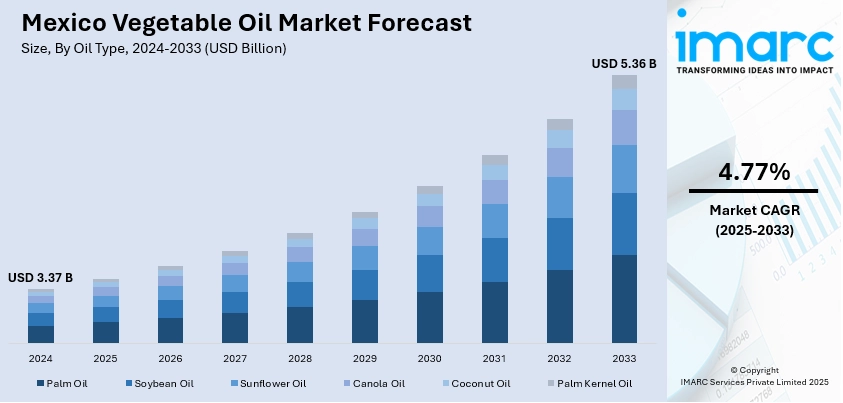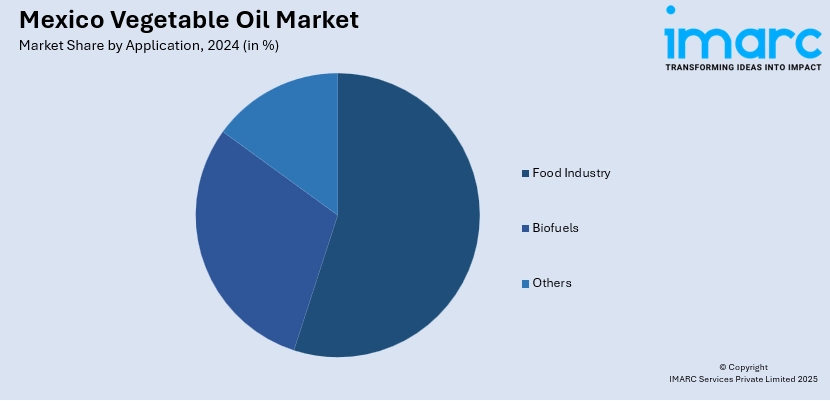
Mexico Vegetable Oil Market Size, Share, Trends and Forecast by Oil Type, Application, and Region, 2025-2033
Mexico Vegetable Oil Market Overview:
The Mexico vegetable oil market size reached USD 3.37 Billion in 2024. Looking forward, the market is projected to reach USD 5.36 Billion by 2033, exhibiting a growth rate (CAGR) of 4.77% during 2025-2033. The market is driven by high-frequency household use and its role in traditional cuisine and street food culture. Industrial processing demand from large food manufacturers and bio-based sectors reinforces supply chain investment. Rising consumer preference for fortified, premium, and health-oriented oils is further augmenting the Mexico vegetable oil market share.
|
Report Attribute
|
Key Statistics
|
|---|---|
|
Base Year
|
2024
|
|
Forecast Years
|
2025-2033
|
|
Historical Years
|
2019-2024
|
| Market Size in 2024 | USD 3.37 Billion |
| Market Forecast in 2033 | USD 5.36 Billion |
| Market Growth Rate 2025-2033 | 4.77% |
Mexico Vegetable Oil Market Trends:
Deep Integration with Traditional Cooking and Street Food Culture
Vegetable oil is deeply embedded in Mexican cuisine, from the preparation of tortillas and tamales to the frying of tacos, churros, and quesadillas. Whether used in households or by street vendors, oil is a daily necessity in both rural and urban areas. Palm, soybean, and canola oils dominate consumption, with distribution tailored to diverse income groups, small sachets for low-income families and bottled products for supermarkets. Total vegetable oil consumption in Mexico is forecast at 3.2 MMT, a 4% increase year-on-year, with soybean oil accounting for 38% of total consumption. Rapeseed oil consumption is projected to increase by 12% to 770,000 MT, while palm oil consumption will grow by 2% to 960,000 MT, and sunflower seed oil consumption will rise by 11% to 50,000 MT. Street food stalls, taquerías, and small eateries contribute significantly to volume demand due to their reliance on repeated deep-frying processes. Bulk oil suppliers cater to these informal food businesses with cost-effective offerings, while urban retailers stock premium and fortified variants targeting health-conscious shoppers. Government nutrition programs have promoted vitamin A-enriched oils to address micronutrient deficiencies in vulnerable populations. Oil remains an indispensable kitchen staple, unaffected by seasonality or shifting food fads. The rising urban population and expanding middle class further drive demand for packaged cooking oil that aligns with hygiene and safety expectations. The cultural centrality of oil in Mexican diets and everyday street food makes culinary tradition a primary engine of Mexico vegetable oil market growth across all social strata.

To get more information on this market, Request Sample
Expanding Role in Food Processing and Industrial Applications
Mexico’s growing packaged food industry heavily depends on refined vegetable oils for manufacturing applications such as frying, dough conditioning, emulsifying, and flavor enhancement. Products including snacks, instant noodles, bakery items, and frozen foods incorporate palm and soybean oils at industrial scale. Large food conglomerates like Grupo Bimbo and Gruma operate oil-intensive production lines that require consistent quality and supply chain stability. Imported palm oil, mainly from Southeast Asia, is refined domestically to serve these needs, while locally produced oils also contribute to supply diversification. Mexico’s total oilseed production for MY 2024/2025 is forecast at 636,000 metric tons (MT), a 4% increase from the previous year. Soybean production is expected to rise by 11%, reaching 205,000 MT, while rapeseed production remains unchanged at 2,000 MT, and palm kernel production is forecast at 75,000 MT, a 1% increase year-on-year. Mexico’s strategic location and trade access under USMCA make it a competitive base for food processing and export, further amplifying demand for high-grade oils. Beyond food, vegetable oils are processed into biodiesel and used in cosmetics, lubricants, and household cleaning agents, contributing to vertical market integration. Industrial growth in northern states like Nuevo León and Jalisco is driving new investments in refining and oleochemical facilities. As manufacturers expand their product portfolios and technological sophistication, vegetable oil remains a key input in production economics and value-chain optimization. This industrial dependence reinforces the strategic role of oil in national food security and manufacturing competitiveness.
Mexico Vegetable Oil Market Segmentation:
IMARC Group provides an analysis of the key trends in each segment of the market, along with forecasts at the country and regional levels for 2025-2033. Our report has categorized the market based on oil type and application.
Oil Type Insights:
- Palm Oil
- Soybean Oil
- Sunflower Oil
- Canola Oil
- Coconut Oil
- Palm Kernel Oil
The report has provided a detailed breakup and analysis of the market based on the oil type. This includes palm oil, soybean oil, sunflower oil, canola oil, coconut oil, and palm kernel oil.
Application Insights:

- Food Industry
- Biofuels
- Others
The report has provided a detailed breakup and analysis of the market based on the application. This includes food industry, biofuels and others.
Regional Insights:
- Northern Mexico
- Central Mexico
- Southern Mexico
- Others
The report has also provided a comprehensive analysis of all major regional markets. This includes Northern Mexico, Central Mexico, Southern Mexico, and others.
Competitive Landscape:
The market research report has also provided a comprehensive analysis of the competitive landscape. Competitive analysis such as market structure, key player positioning, top winning strategies, competitive dashboard, and company evaluation quadrant has been covered in the report. Also, detailed profiles of all major companies have been provided.
Mexico Vegetable Oil Market Report Coverage:
| Report Features | Details |
|---|---|
| Base Year of the Analysis | 2024 |
| Historical Period | 2019-2024 |
| Forecast Period | 2025-2033 |
| Units | Billion USD |
| Scope of the Report |
Exploration of Historical Trends and Market Outlook, Industry Catalysts and Challenges, Segment-Wise Historical and Future Market Assessment:
|
| Oil Types Covered | Palm Oil, Soybean Oil, Sunflower Oil, Canola Oil, Coconut Oil, Palm Kernel Oil |
| Applications Covered | Food Industry, Biofuels, Others |
| Regions Covered | Northern Mexico, Central Mexico, Southern Mexico, Others |
| Customization Scope | 10% Free Customization |
| Post-Sale Analyst Support | 10-12 Weeks |
| Delivery Format | PDF and Excel through Email (We can also provide the editable version of the report in PPT/Word format on special request) |
Key Questions Answered in This Report:
- How has the Mexico vegetable oil market performed so far and how will it perform in the coming years?
- What is the breakup of the Mexico vegetable oil market on the basis of oil type?
- What is the breakup of the Mexico vegetable oil market on the basis of application?
- What is the breakup of the Mexico vegetable oil market on the basis of region?
- What are the various stages in the value chain of the Mexico vegetable oil market?
- What are the key driving factors and challenges in the Mexico vegetable oil market?
- What is the structure of the Mexico vegetable oil market and who are the key players?
- What is the degree of competition in the Mexico vegetable oil market?
Key Benefits for Stakeholders:
- IMARC’s industry report offers a comprehensive quantitative analysis of various market segments, historical and current market trends, market forecasts, and dynamics of the Mexico vegetable oil market from 2019-2033.
- The research report provides the latest information on the market drivers, challenges, and opportunities in the Mexico vegetable oil market.
- Porter's five forces analysis assist stakeholders in assessing the impact of new entrants, competitive rivalry, supplier power, buyer power, and the threat of substitution. It helps stakeholders to analyze the level of competition within the Mexico vegetable oil industry and its attractiveness.
- Competitive landscape allows stakeholders to understand their competitive environment and provides an insight into the current positions of key players in the market.
Need more help?
- Speak to our experienced analysts for insights on the current market scenarios.
- Include additional segments and countries to customize the report as per your requirement.
- Gain an unparalleled competitive advantage in your domain by understanding how to utilize the report and positively impacting your operations and revenue.
- For further assistance, please connect with our analysts.
 Request Customization
Request Customization
 Speak to an Analyst
Speak to an Analyst
 Request Brochure
Request Brochure
 Inquire Before Buying
Inquire Before Buying




.webp)




.webp)












